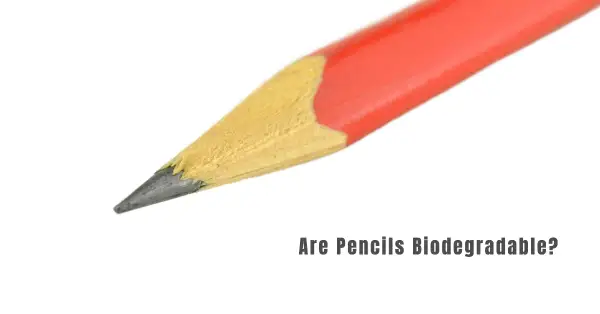Are Pencils Biodegradable?
Pencils are made from a variety of materials, including wood, graphite, and lead. Wood is a natural material that is biodegradable, but graphite and lead are not.
However, most pencils are coated with a waxy substance that helps protect the graphite and lead from the elements, which can slow down the biodegradation process.

In general, pencils can take anywhere from a few months to a few years to biodegrade completely.
The exact amount of time it takes for a pencil to biodegrade depends on a number of factors, including the type of wood used, the thickness of the pencil, and the environmental conditions.
If you are concerned about the environmental impact of pencils, you can choose to buy pencils that are made from recycled materials or that are biodegradable. You can also recycle your old pencils when you are finished with them.
What Are Biodegradable Pencils?
Support us by using our links. We may earn a commission, but it won’t cost you extra. Win-win shopping
Biodegradable pencils are pencils that are made from materials that can be broken down by natural processes, such as bacteria and fungi.
This means that they will not contribute to the build-up of waste in landfills. Biodegradable pencils are typically made from materials such as bamboo, cornstarch, or recycled paper.
Benefits of Using Biodegradable Pencils
There are many benefits to using biodegradable pencils, including:
- They are better for the environment. Biodegradable pencils are made from materials that will break down naturally over time, unlike traditional pencils which are made from wood that can take hundreds of years to decompose.
- They are more sustainable. Biodegradable pencils are made from renewable resources, such as bamboo or cornstarch, which means that they can be replaced without depleting natural resources.
- They are better for your health. Biodegradable pencils are made from non-toxic materials, so they are less likely to cause allergic reactions or other health problems.
In addition to these environmental and health benefits, biodegradable pencils also have a number of practical advantages over traditional pencils.
They are often stronger and more durable, making them less likely to break. They also write smoother and produce a darker line, making them ideal for writing and drawing.
Drawbacks of Using Biodegradable Pencils
There are a few drawbacks to using biodegradable pencils:
- Biodegradable pencils are typically more expensive than traditional pencils.
- Biodegradable pencils can be harder to find than traditional pencils.
- Biodegradable pencils may not be as durable as traditional pencils.
Overall, the drawbacks of using biodegradable pencils are relatively minor. However, it is important to be aware of these drawbacks before making a decision about whether or not to use biodegradable pencils.
Where to Buy Biodegradable Pencils
You can buy biodegradable pencils online and in some retail stores. Here are a few places to find biodegradable pencils:
You can also find biodegradable pencils at some local businesses, such as health food stores and co-ops.
Conclusion
Pencils are made of wood, which is a natural material, but the graphite core is not. Graphite is a mineral, and minerals are not biodegradable.
This means that pencils will not decompose over time. They will eventually break down into smaller pieces, but they will not fully decompose into the same elements that they were made of.
This is why it is important to recycle pencils whenever possible. Recycling pencils helps to keep them out of landfills and reduces the amount of waste that is produced.
